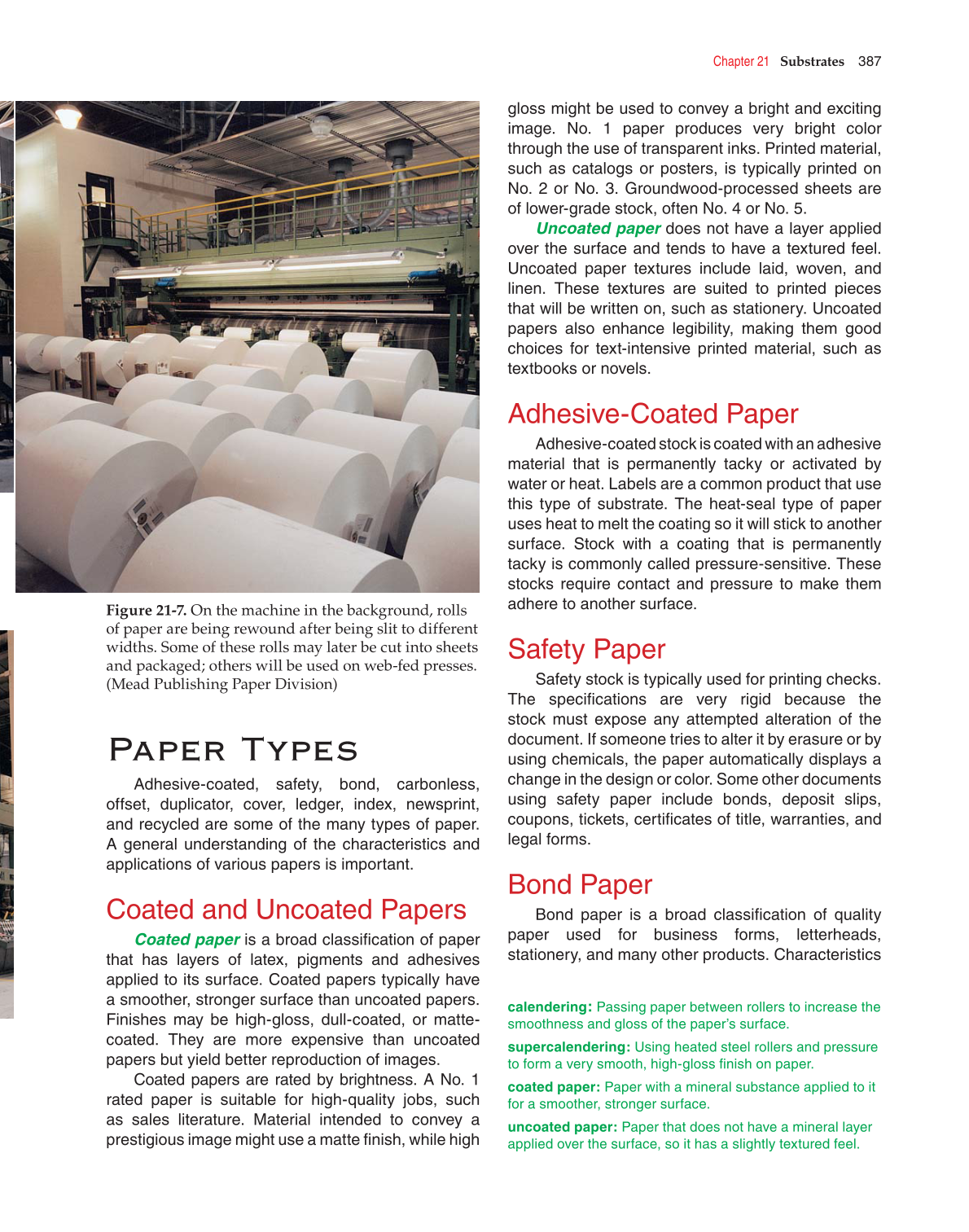Chapter 21 Substrates 387
Paper Types
Adhesive-coated, safety, bond, carbonless,
offset, duplicator, cover, ledger, index, newsprint,
and recycled are some of the many types of paper.
A general understanding of the characteristics and
applications of various papers is important.
Coated and Uncoated Papers
Coated paper is a broad classifi cation of paper
that has layers of latex, pigments and adhesives
applied to its surface. Coated papers typically have
a smoother, stronger surface than uncoated papers.
Finishes may be high-gloss, dull-coated, or matte-
coated. They are more expensive than uncoated
papers but yield better reproduction of images.
Coated papers are rated by brightness. A No. 1
rated paper is suitable for high-quality jobs, such
as sales literature. Material intended to convey a
prestigious image might use a matte fi nish, while high
gloss might be used to convey a bright and exciting
image. No. 1 paper produces very bright color
through the use of transparent inks. Printed material,
such as catalogs or posters, is typically printed on
No. 2 or No. 3. Groundwood-processed sheets are
of lower-grade stock, often No. 4 or No. 5.
Uncoated paper does not have a layer applied
over the surface and tends to have a textured feel.
Uncoated paper textures include laid, woven, and
linen. These textures are suited to printed pieces
that will be written on, such as stationery. Uncoated
papers also enhance legibility, making them good
choices for text-intensive printed material, such as
textbooks or novels.
Adhesive-Coated Paper
Adhesive-coated stock is coated with an adhesive
material that is permanently tacky or activated by
water or heat. Labels are a common product that use
this type of substrate. The heat-seal type of paper
uses heat to melt the coating so it will stick to another
surface. Stock with a coating that is permanently
tacky is commonly called pressure-sensitive. These
stocks require contact and pressure to make them
adhere to another surface.
Safety Paper
Safety stock is typically used for printing checks.
The specifi cations are very rigid because the
stock must expose any attempted alteration of the
document. If someone tries to alter it by erasure or by
using chemicals, the paper automatically displays a
change in the design or color. Some other documents
using safety paper include bonds, deposit slips,
coupons, tickets, certifi cates of title, warranties, and
legal forms.
Bond Paper
Bond paper is a broad classifi cation of quality
paper used for business forms, letterheads,
stationery, and many other products. Characteristics
Figure 21-7. On the machine in the background, rolls
of paper are being rewound after being slit to different
widths. Some of these rolls may later be cut into sheets
and packaged; others will be used on web-fed presses.
(Mead Publishing Paper Division)
calendering:
Passing paper between rollers to increase the
smoothness and gloss of the paper’s surface.
supercalendering: Using heated steel rollers and pressure
to form a very smooth, high-gloss fi nish on paper.
coated paper: Paper with a mineral substance applied to it
for a smoother, stronger surface.
uncoated paper: Paper that does not have a mineral layer
applied over the surface, so it has a slightly textured feel.
